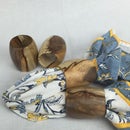Introduction: Mousetrap Powered Boat
My kids and I love playing with and building stuff that can move, doesn't matter if it is a car, plane or boat. Mouse trap powered cars are pretty common so I thought it would be fun to try something a bit different. Plus, it will mean playing in the stream behind my house which is always fun!
Material, I designed this boat to use material that most people already have around the house.
- Two pencils, 1 for the back axle and the other for the pulling arm
- paint stir stick
- 1 CD
- Fishing line, or any string/ribbon that you want to use
- 20oz pop bottle, any plastic bottle would also work just as well
- Cork
- Foam, anything that floats would also work just fine
- 2 zip ties, to hold the pencil to the mousetrap arm
- 1 Metal hanger
- Of course - 1 mouse trap
Tools, most are kid friendly but adult supervision is required
- Low temp hot glue gun
- razor (adult should use this)
- scissor
- wire snips
- needle nose pliers
- electrical tape, or any other water resistant tape
- drill, drill bit should be the same diameter as the pencils being used
Step 1: Mouse Trap Prep
You will only need the main spring and arm on the mouse trap so the release arm and bait holder can be removed. Using the two zip ties, attach 1 of the pencils to the trap's arm. Very simple!
Step 2:
I choose to have 4 paddles in my design so I simply cut out the straight portion of a 20oz bottle and cut that column into 4 equal pieces. Each paddle will need to have a thin notch cut into it so it will be able to slip onto the CD. Draw 2 perpendicular lines on both sides of the CD. These lines will help insure that the paddles are glued onto the CD straight. Center the CD on the cork and draw a circle on the cork so you know how big the CD opening is. The cork will be used as the paddle wheel hub.
Drill a hole through the center of the cork that is the same size as the pencil (a parent should probably do the drilling and cutting the cork). I wanted the CD to rest near the middle of the cork so I scored a line around the cork with a razor and then reduced the OD of the cork to allow the CD to slide over it.
Now it is time for glueing, kids might ask for help with this step but it doesn't have to be perfect. Slide each paddle over the pre-drawn lines and run a bead of hot glue along each edge of the paddle. Wait for the glue to cool a bit before moving onto the next paddle, this should minimize bumping them out of alignment. Make sure that all paddles are pointed in the same direction. Slide the CD onto the cork hub and glue that in place as well. Slide the pencil through the cork, if it isn't a tight fit glue that in place as well. You now have a completed paddle wheel!
Step 3: Paddle Wheel Supports
To hold the back end of the boat together I choose to use a metal clothing hanger. Snip off the lower portion of the hanger and bend it similar to the first picture above. Bend the top of the hanger so it will fit the width of the paint stir stick. It worked out well attaching the hanger to the stir stick with electrical tape. The ends of the hanger can be bent and positioned however you like to accommodate the size of your paddle wheel. I choose to bend the ends of the hanger down so they could be pushed into the foam, this wasn't necessary but resulted in fewer potential sharp edges. Wrap tape around each of the foam blocks to attach it to the wire hanger. Originally I had the paddle's shaft go through the foam blocks but this resulted in the paddle being too far into the water and not able to turn very fast. A better way is to glue sections of a straw to the tops of both foam blocks and run the axle through these. This arrangement is shown latter on.
Tape a foam block to the front of the boat in the same fashion as the foam in the back. Place the mouse trap (motor) on the stir stick so the pull arm is almost touching the back axle when the mouse trap is pulled back. I offset the mouse trap on the stir stick to insure that the pull arm would not interfere with the paddle wheel. Place a little bit of hot glue under the mouse trap base to prevent it from sliding and then use tape to hold it in place on top of that, you don't want your engine being ripped off! Your boat should look something like the picture above at this point.
Step 4: Securing the String
Measure out a length of fishing line that is about 5" longer than the distance from the back axle to the tip of the pencil attached to the mouse trap. Pull the mouse trap back and look where the pull pencil lines up with the back axle. Tie the fishing line with a simple knot onto the axle at this point. Place a dab of hot glue on the knot to hold it in place. Once cooled, any extra line can be trimmed off. Score the tip of the pull arm with the razor. Stretch the line and press it into the score mark you just made, allow a little bit of slack in the line. Tie the string to the end of the pull arm and again glue it in place. Trim off any extra string and you should now have a functioning paddle boat!
Step 5: Improvements and Finished Product
I noticed that the pencil axle rubbed a little bit in the foam floats so initially I slid a section of straw over the pencil to help things slide better. After a trial run I realized that the paddle was too low in the water and was having to push too much water. I glued the straw sections to the top of the foam floaters and not only did the paddle wheel spin faster and the boat go faster but it also was much easier to make sure the axle was aligned with the body of the boat! Depending on how straight the boat goes you can bend the back end to adjust how straight your new boat travels.
Don't forget about decorations! I went with a simple Lego figure at the front of the craft but I think it would look cool to add a flag to the pull arm or any number of other cool ideas. This is a simple project that can be done almost entirely by kids and all of the materials are probably somewhere in your house already. I would love to see your designs and I hope you have a great time building your very own mousetrap powered paddle boat.

Participated in the
DIY Summer Camp Challenge

Participated in the
Beyond the Comfort Zone Contest











